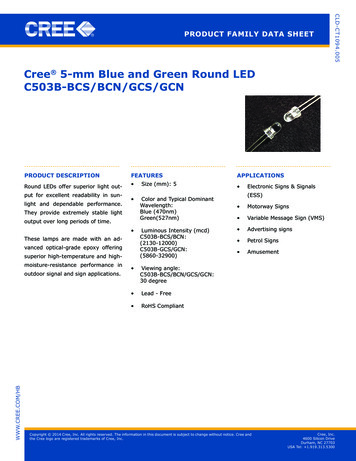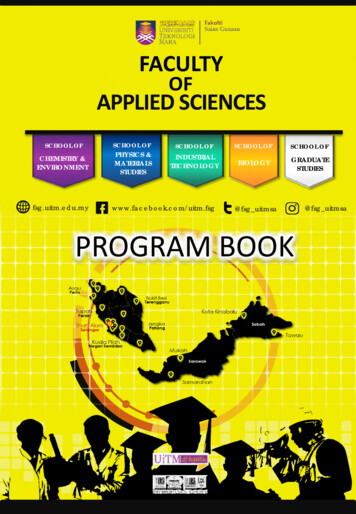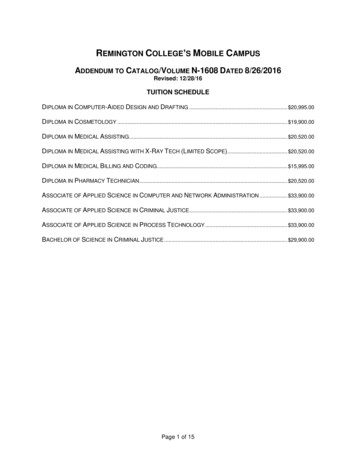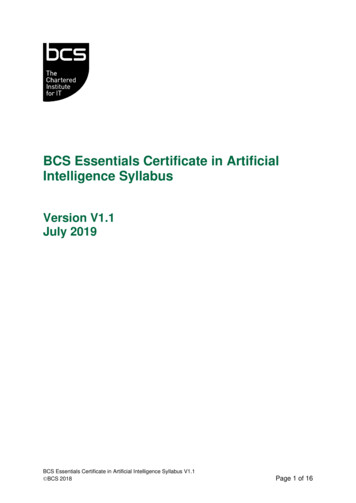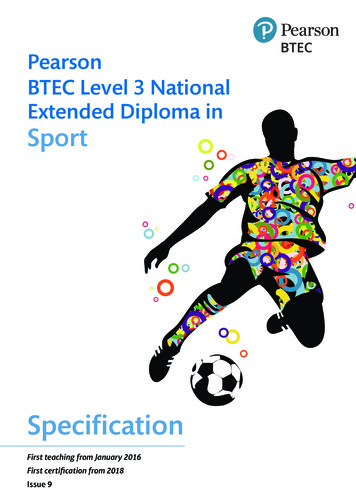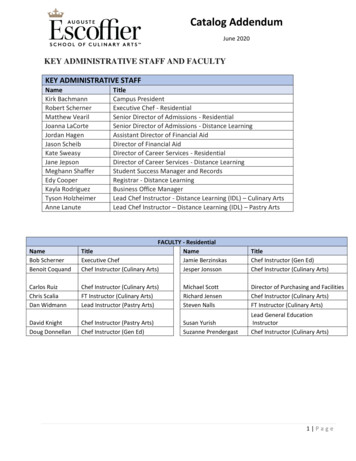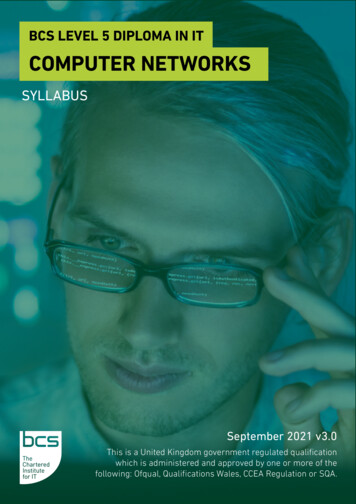
Transcription
BCS LEVEL 5 DIPLOMA IN ITCOMPUTER NETWORKSSYLLABUSSeptember 2021 v3.0This is a United Kingdom government regulated qualificationwhich is administered and approved by one or more of thefollowing: Ofqual, Qualifications Wales, CCEA Regulation or SQA.
CONTENTS3. Introduction4. Qualification Suitability and Overview4. SFIA Levels5. Learning Outcomes6. Syllabus10. Examination Format10. Question Weighting11. Recommended Reading11. Using BCS Books
IntroductionThe second stage within the BCS three-stage Higher Education Qualification programme, the Level 5Diploma enables candidates who have already achieved the Level 4 Certificate in IT to progress to higherlevels of knowledge and competency.This internationally-recognised qualification introduces you to the business-related aspects of the ITindustry, developing your technological expertise while also considering the potential challenges of the dayto-day running of an organisation, such as legal obligations and intellectual property.Our modules have been created in-line with the latest developments in the industry, giving you acompetitive edge in the IT job market. You will have the opportunity to learn about object-orientedprogramming, user experience, systems analysis and design, as well as to build upon knowledge and skillsdeveloped during the Level 4 Certificate.To successfully achieve the qualification, candidates need to complete: One core moduleThree optional modulesOne Professional Project in ITCandidates who wish to progress onto the next stage will need to complete the Project at end of the Level 6Professional Graduate Diploma in IT.Computer Networks Optional ModuleThe Computer Networks module is an optional module that forms part of the Level 5 Diploma in IT – thesecond stage within the BCS three-stage Higher Education Qualification programme.Candidates will develop specialist knowledge and skills relating to network architecture, the physicalproperties of communication standards, analysing errors and their impact, LANs and topologies, WANtechnology, the principles of inter-networking, and the main parameters of network performance.3
Qualification Suitability andOverviewCandidates must have achieved the Certificate in IT or have an appropriate exemption to be entered forthe Diploma in IT. Candidates can study for this diploma by attending a training course provided by a BCSaccredited Training Provider or through self-study, although it is strongly recommended that all candidatesregister with an approved centre. Studying with an approved centre will deliver significant benefits.Candidates are required to become a member of BCS, The Chartered Institute for IT, to sit and be awardedthe qualifications. Candidates may apply for a four-year student membership that will support themthroughout their studies.The Level 5 Diploma is suitable for professionals wishing to gain a formal IT qualification, and thismodule may be particularly relevant for candidates interested in career opportunities such as solutionsarchitecture, network engineering, or database programming.Total Qualification Time(Certificate)Guided Learning Hours(Module)Assessment Time(Exam)1086 hours225 hoursTwo hoursSFIA LevelsThis award provides candidates with the level of knowledge highlighted within the table, enablingcandidates to develop the skills to operate successfully at the levels of responsibility indicated.LevelLevels of KnowledgeK7Levels of Skill and Responsibility (SFIA)Set strategy, inspire and mobiliseK6EvaluateInitiate and influenceK5SynthesiseEnsure and tK1RememberFollow4
SFIA PlusNTDS3This syllabus has been linked to the SFIAknowledge skills and behaviours required at Level5.Produces outline system designs andspecifications, and overall architectures, topologies,configuration databases and design documentationof networks and networking technology within theorganisation. Specifies user/system interfaces,including validation and error correctionprocedures, processing rules, access, securityand audit controls. Assesses associated risks,and specifies recovery routines and contingencyprocedures. Translates logical designs into physicaldesigns.ITOP3Carries out agreed operational procedures,including infrastructure configuration, installationand maintenance. Uses infrastructure managementtools to collect and report on load and performancestatistics and to automate the provisioning,testing and deployment of new and changedinfrastructure. Contributes to the implementation ofmaintenance and installation work. Uses standardprocedures and tools to carry out defined systembackups, restoring data where necessary. Identifiesoperational problems and contributes to theirresolution.NTAS3Identifies and resolves network problems followingagreed procedures. Uses network managementsoftware and tools to collect agreed performancestatistics. Carries out agreed network maintenancetasks.Further detail around the SFIA Levels can be found at www.bcs.org/levels.Learning OutcomesUpon completion of this module, candidates will be able to: demonstrate an understanding of the physical properties and performance characteristics ofcommunication media; specifically, copper cable, fibre optics and wireless networksdemonstrate an understanding of the importance of communication standards, including anappreciation of protocol layer models and enhancements to those standardsdemonstrate an appreciation of the theory and practice of common local area networks including virtualand wireless LANsdemonstrate an appreciation of the theory and practice of wide area networks and their interconnectiondemonstrate an appreciation of the significance of network and inter-network protocols; specifically,IPv4, IPv6, TCP and UDPdescribe the importance of reliability and quality of service, including examples of error recoverystrategies, traffic differentiation and prioritisation5
Syllabus1. IntroductionLearners will be able to:1.1 Explain the theoretical and practical models of network architecture.Indicative contentGuidancea. Historical perspectiveb. Theoretical and practicalmodels of networkarchitecture, particularly theISO OSI seven-layer modeland the TCP/IP protocol stackc. Example networks andservices, including LAN andWAN technologies, and theirrelevance to the OSI model.Candidates are expected to understand the purpose of each of thelayers in both models and the mapping between both models. Thedifference between this syllabus and BCS Certificate Computerand Network Technology is that, at this level, candidates should beable to explain how the models’ layers interact with each other, e.g.to explain the journey of a message through the different layers.Example networks and technologies would include packet andcircuit switching, for example - ethernet, ISDN, ATM, Wi-Fi, xDSL,WiMAX. Candidates should explain how LAN and WAN technologiesrelate to different models and their respective layers6
2. Digital CommunicationLearners will be able to:2.1 Describe the physical properties of communication standards.Indicative contentGuidancea. Physical properties oftransmission mediastandards, for example, fibreoptics, radio communicationb. Maximum data rates(theoretical and practical) fordifferent transmission mediastandards, including somesimple analysis of signalsc. Data encoding of digitalsignalsd. The distinction between,and analysis of, physicalmedia and wireless mediapropertiese. The difference betweennarrowband and broadbandtechnologies with referenceto ISDN and xDSLAt the physical layer of the OSI/TCP IP models, we can havedifferent layers of transmission media standards. Candidatesshould be able to identify the different types of media and theircharacteristics, e.g. maximum data rates they can support.In this regard, candidates should be able to describe the dataencoding methods of digital signals. The focus here is on conceptof data encoding itself. Candidates should differentiate betweenphysical and wireless media properties, and understand fibreoptics and other examples. They will also need to differentiatebetween narrowband and broadband, and how these are used intechnologies such as ISDN and xDSL.3. ErrorsLearners will be able to:3.1 Analyse errors and their impact.Indicative contentGuidancea. The main causes oferrors and their effects ontransmissionb. Single-bit and burst errorsc. Various error detectionand correction strategiesincluding parity, block sum,Hamming Codes, CyclicRedundancy Checks, andForward versus Backwarderror controlCandidates should understand main causes of errors and theirimpact on transmission. They should be able to differentiatebetween single-bit and burst errors. Candidates should also beable to identify the most appropriate error detection and correctionstrategy for handling the error.7
4. Local Area NetworksLearners will be able to:4.1 Describe LANs and explain topologiesIndicative contentGuidancea. Types of LAN coveringstandards, topology andperformanceb. Example architecturessuch as Ethernet and fastEthernet, and Wi-Fic. Operating LAN switches andconfiguring virtual LANsHere the focus is on LAN standard IEEE802.3 (Ethernet). Candidatesshould be able to describe different layers and how these relate tothe OSI model, so that we can see logical evaluation of the topics,including LAN topologies, e.g. bus, ring, star, mesh, cellular andhybrid. Candidates should also be aware of IEEE802.11 (wifi) andits architecture. Candidates will be asked about the purpose of LANswitches, how they operate and how they can support creation ofvirtual LANs.5. Wide Area NetworksLearners will be able to:5.1 Analyse WAN technology.Indicative contentGuidancea. Circuit versus packetswitching and associatedrouting and flow controlb. Detailed examples of existingarchitectures such asISDN, Multi-protocol LabelSwitching (MPLS)c. Virtual Private Networks(VPN) and their relevance toWANsCandidates should go into more detail in terms of analysing circuitswitching and packet switching, including routing and flow control.They are expected to be able to identify examples of architecturesworking with these technologies, e.g. ISDN would be circuitswitched, whereas the internet is packet switched. Candidates willbe asked to describe the concept of VPNs and how they work in aWAN environment.8
6. Inter-NetworksLearners will be able to:6.1 Describe the principles of inter-networking.Indicative contentGuidancea. Architectures, addressingand protocolsb. Reference to IPv4, IPv6, TCPand UDPThis is where we go into more detail on Layers 3 and 4 of OSImodel. Candidates are expected to know details of IPv4 and IPv6,including addressing schemes, operation and other relevantprotocols. They should also know main differences betweentransport protocols (UDP, TCP) and be able to provide examplesof when an application uses one instead of the other. They shouldknow purpose of transport layer (layer 4), as well as networkinglayer (layer 3).7. Quality of ServiceLearners will be able to:7.1 Explain the definition of service and the main parameters that define network performance.Indicative contentGuidancea. A definition of qualityof service and the mainparameters that definenetwork performanceb. Router functionality includingframe prioritisation,classification and queuemanagement techniquesc. The provision of quality ofservice management inproduction networksWe expect candidates to be able to define the concept of quality ofservice by also identifying main parameters that define networkperformance, e.g. throughput, jitter, delay. The router plays a veryimportant role in achieving quality of service, so candidates areexpected to be able to describe the functionality implemented bythe router, including frame prioritisation, classification and queuemanagement techniques. Candidates should describe protocolsthat network administrators use to implement quality of service ina production network, such as RSVP and DiffServ.9
Examination FormatThis module is assessed through completion of an invigilated written exam.Type Four written questions from a choice of six, each with equal marksDuration Two hoursSupervised YesOpen Book No (no materials can be taken into the examination room)Passmark 10/25 (40%)Delivery Paper format onlyAdjustments and/or additional time can be requested in line with the BCS reasonable adjustments policyfor candidates with a disability or other special considerations.Question WeightingCandidates will choose four questions from a choice of six. All questions are equally weighted and worth 25marks10
Recommended ReadingPrimary textsTitle: Data and Computer Communications (10th edition)Author: W. StallingsPublisher: Pearson EducationDate: 2013ISBN: 978-1292014388Title: Computer Networks (5th edition)Author: A. TanenbaumPublisher: Pearson EducationDate: 2013ISBN: 978-1292024226Additional textsTitle: Wireless Communication and Networks (second edition)Author: W. StallingsPublisher: Pearson EducationDate: 2015ISBN: 978-1292027388Using BCS BooksAccredited Training Organisations may include excerpts from BCS books in the course materials. If youwish to use excerpts from the books you will need a license from BCS. To request a license, please contactthe Head of Publishing at BCS outlining the material you wish to copy and its intended use.11
Document Change HistoryAny changes made to the syllabus shall be clearly documented with a change history log. This shall includethe latest version number, date of the amendment and changes made. The purpose is to identify quicklywhat changes have been made.Version NumberChanges MadeVersion 1.0June 2021Document Creation12
CONTACTFor further information please contact:BCSThe Chartered Institute for IT3 Newbridge SquareSwindonSN1 1BYT 44 (0)1793 417 445www.bcs.org 2021 Reserved. BCS, The Chartered Institute for ITAll rights reserved. No part of this material protected by this copyright may be reproduced or utilised in any form,or by any means, electronic or mechanical, including photocopying, recording, or by any information storage andretrieval system without prior authorisation and credit to BCS, The Chartered Institute for IT.Although BCS, The Chartered Institute for IT has used reasonable endeavours in compiling the document it does notguarantee nor shall it be responsible for reliance upon the contents of the document and shall not be liable for anyfalse, inaccurate or incomplete information. Any reliance placed upon the contents by the reader is at the reader’ssole risk and BCS, The Chartered Institute for IT shall not be liable for any consequences of such reliance.Copyright BCS 2021BCS Level 5 Diploma in IT Computer Networks v1.0
Title: Data and Computer Communications (10th edition) Author: W. Stallings Publisher: Pearson Education Date: 2013 ISBN: 978-1292014388 Title: Computer Networks (5th edition) Author: A. Tanenbaum Publisher: Pearson Education Date: 2013 ISBN: 978-1292024226 Primary texts Title: Wireless Communication and Networks (second edition) Author: W .

